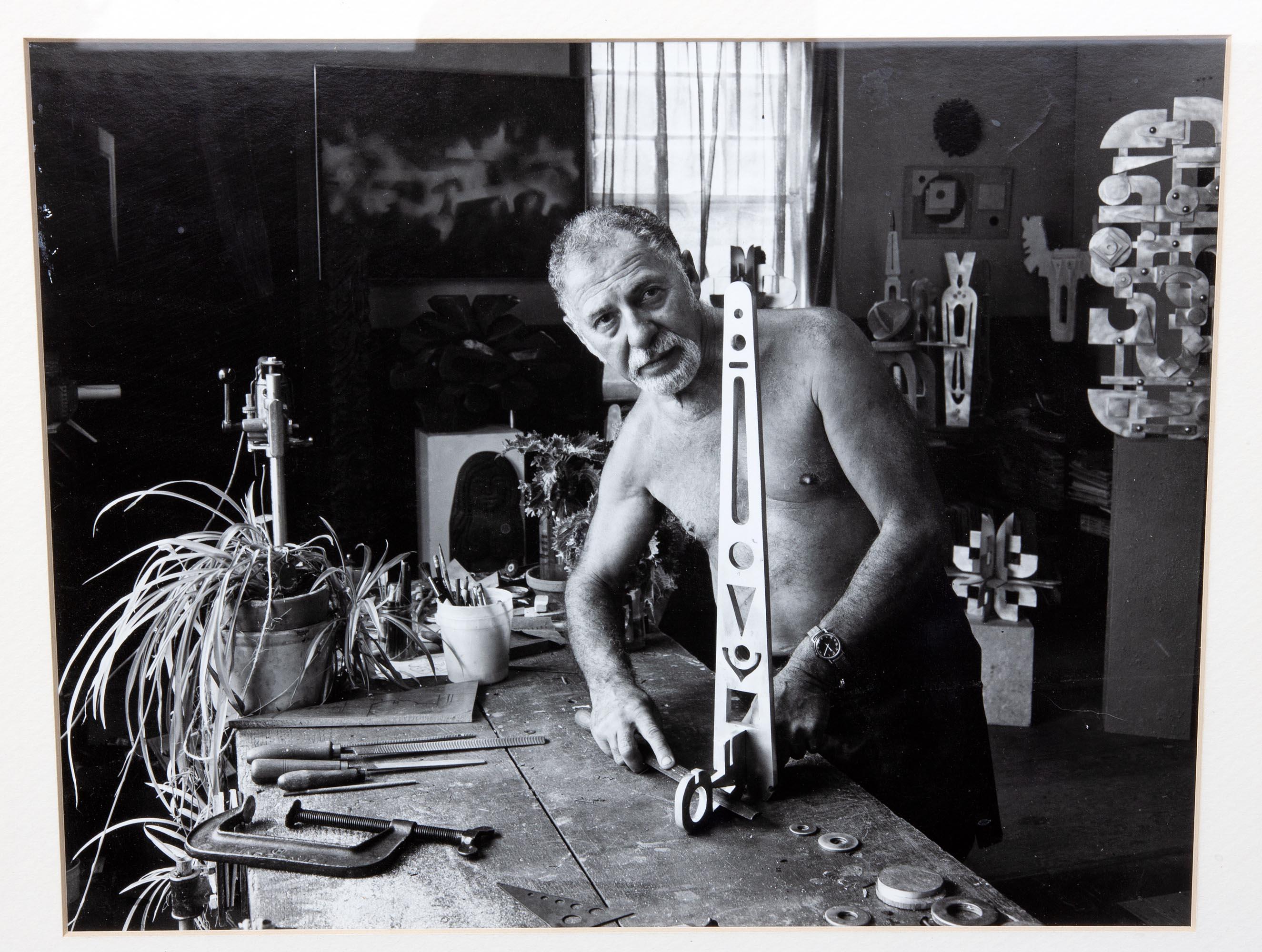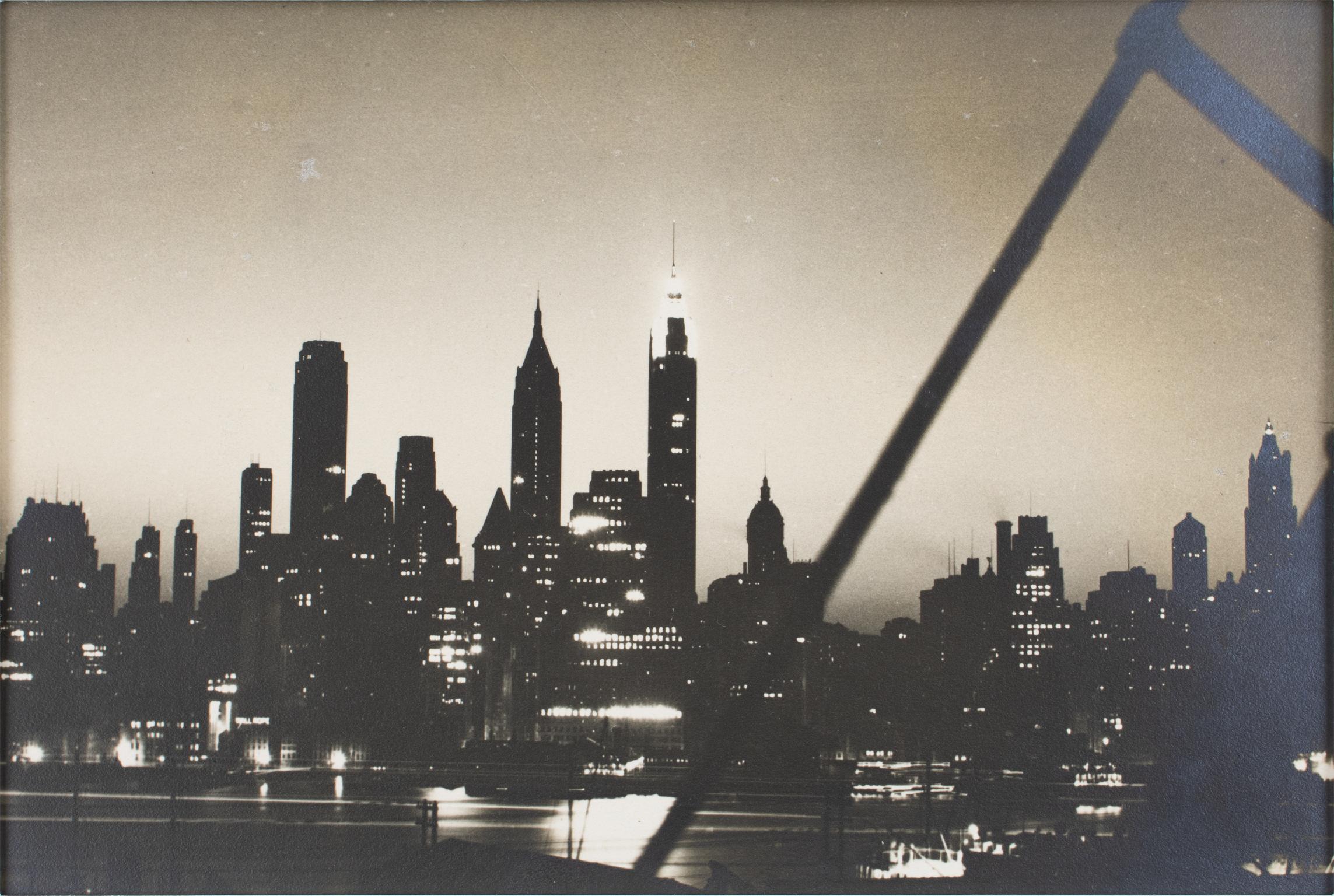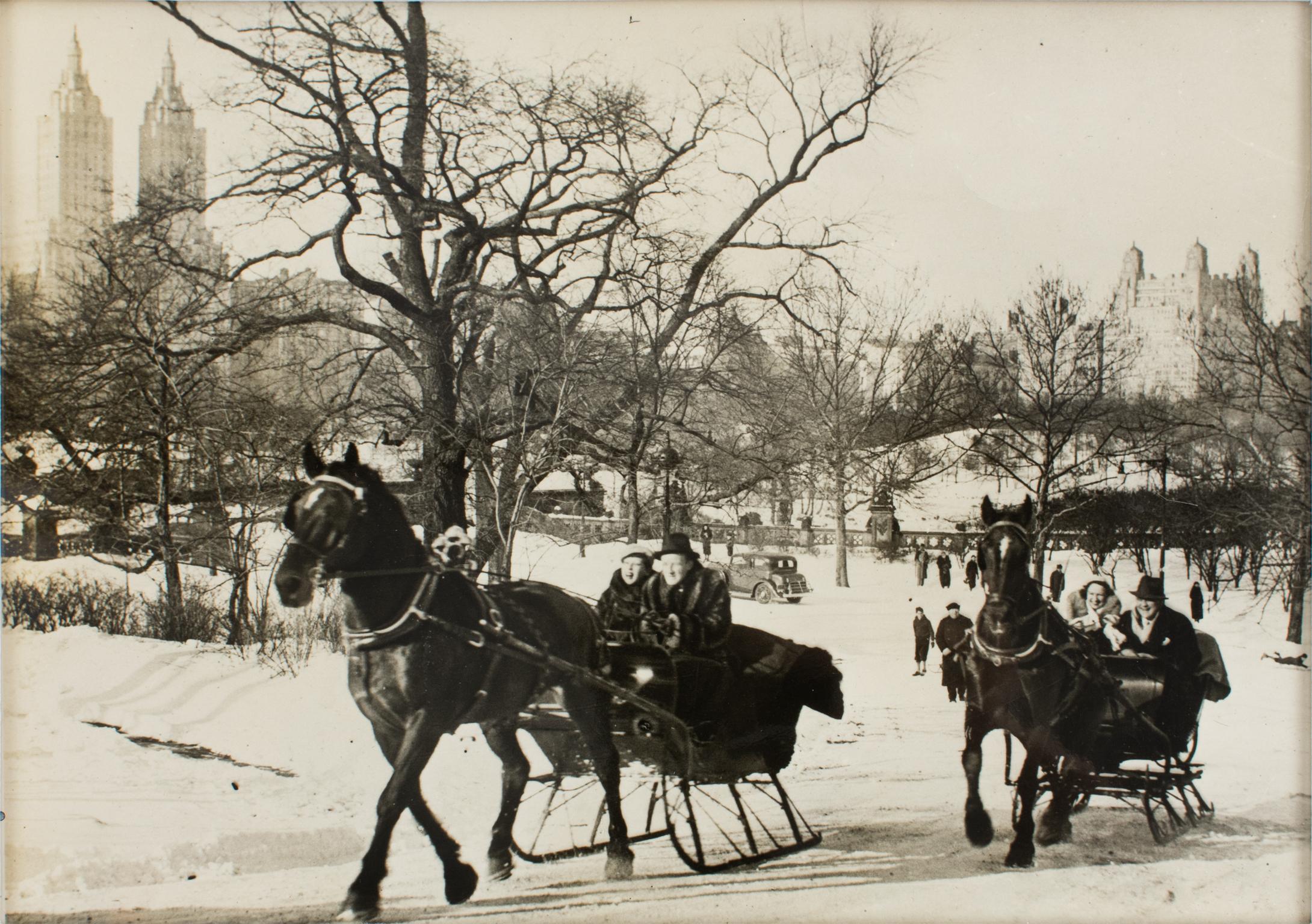Items Similar to Ballerina
Want more images or videos?
Request additional images or videos from the seller
1 of 10
WeegeeBallerinacirca 1950s
circa 1950s
About the Item
Arthur Felling, better known as Weegee (1899-1968) is America's premiere photojournalist and one of the last century's most influential photographers.
He would become famous, beyond New York and news circles, after the publication of his photo books Naked City (1945) and Weegee's People (1946).
Weegee's images of New York City crime, disaster, and tragedy are frequently iconic and highly influential. Less well-known, however, is the work he focused on during the last twenty years of his life: known as the 'distortions' period.
In the late 1940s, Weegee began experimenting with photographic manipulation both in the darkroom and using an array of filters, many of which were his own invention, on his camera.
Weegee created distortions of a wide range of subjects; celebrities, architecture, circus life, and nudes. Of course, one of the overarching themes of his work was the idea of spectacle.
The striking image features an elegant ballerina, poised en pointe, with her arms delicately arched above her head as she looks forward with a confident gaze. The photograph captures a fleeting moment, while its subtle distortions elongate the ballerina's lithe figure, emphasizing the grace of her technique.
Weegee’s photography can be found in scores of museums and private collections worldwide: the J. Paul Getty Museum, Los Angeles; Museum of Modern Art, New York; San Francisco Museum of Modern Art; Museum of Modern Art, Oxford; Museum of Contemporary Art, Los Angeles; International Center of Photography, New York and more.
Questions about this piece? Contact us. Visit our Toronto gallery on Thursdays or by appointment.
Untitled "Ballerina"
USA, c. 1950
Gelatin silver print
9"H 6.5"W (work)
20.25"H 16.25"W (framed)
Stamped verso
Very good condition
- Creator:Weegee (1899-1968, American)
- Creation Year:circa 1950s
- Dimensions:Height: 9 in (22.86 cm)Width: 6.5 in (16.51 cm)
- Medium:
- Movement & Style:
- Period:
- Condition:Very good condition.
- Gallery Location:Toronto, CA
- Reference Number:
About the Seller
4.8
Vetted Seller
These experienced sellers undergo a comprehensive evaluation by our team of in-house experts.
Established in 2009
1stDibs seller since 2015
172 sales on 1stDibs
Typical response time: <1 hour
- ShippingRetrieving quote...Ships From: Toronto, Canada
- Return PolicyA return for this item may be initiated within 3 days of delivery.
More From This SellerView All
- GardeniaBy Robert MapplethorpeLocated in Toronto, OntarioRobert Mapplethorpe earned his place in the canon from his incredible output of images that ranged from beautiful to brutal. Mapplethorpe was one of the key artists who helped elevate photography from image-making to fine art. Mapplethorpe (1946-1989) fearlessly depicted the body (his own, friends' and lovers') in a way that positioned his work in line with masters such as Reubens, Courbet and Eadweard Muybridge to mention a few. Despite the sometimes shocking content of his work, Mapplethorpe's photographs possess a formalist quality with their undeniable beauty and strict compositions. From 1978-1981, Mapplethorpe created thirty-nine black and white photographs that make up his acclaimed XYZ Portfolios. While each portfolio is a distinct exploration of Mapplethorpe's signature subject matter, when combined, XYZ Portfolios serves as a definitive and in-depth representation of his mature and most sought-after, period. (Of the portfolios, X explores homosexuality and sadomasochism; Y features floral still life; while Z showcases portraits of Black men) Click here to see a portrait from the Z portfolio. In 2012, the XYZ Portfolios were shown in an exhibition at LACMA and presented in three rows (X on top, followed by Y in the middle, and Z below) as Mapplethorpe had envisioned them in 1989. "Gardenia" is one of thirteen images from the Y Portfolio, featuring a fragrant and graphic flower. Shot overhead, this tranquil image captures a delicate flower subtly floating in a dark, contrasting bowl. Aside from the flower's shadow below, the still water is nearly inconspicuous, contributing to the air of grace and elegance that this piece evokes. While the depiction is straightforward, Mapplethorpe's contrasts lead to a more ambiguous image; is this actually a flower or some alien specimen being examined? This powerful black and white image is a prime example of Mapplethorpe's work, highlighting his studio-centric practice as well as his refined and meticulous printing. This is a rare opportunity to acquire an iconic work by one of the most influential photographers of the 20th Century. Caviar20 is proud to be offering this monumental and important piece. "Gardenia" USA, 1978 Gelatin silver print Signed in ink by Michael Ward Stout and credited and dated on photographer's estate stamp, mount verso. 13.25"H 12.75"W (image) 16.75"H 16"W (framed) Very good condition Provenance: Xavier Hufkens...Category
1970s American Modern Black and White Photography
MaterialsSilver Gelatin
- Weegee "A Trip to Mars"By WeegeeLocated in Toronto, OntarioWhile many first associate Weegee (aka Arthur Fellig) with New York City crime scenes, perhaps a broader and more consistent theme is that of spectacle and/or urban entertainment. The origins of his nick-name and reputation date back to the 1930s when he became the first New York City press photographer to obtain permission to install a police radio in his car. Following the city's first responders and documenting their duties, Weegee had unprecedented access to New York’s fires, crimes, debaucheries and of course, murders. During the first decade of his career these unflinching urban tragedy or crime images paid Weegee's bills, but as he became more financially independent he was more inspired to pursue photographs on his own agenda. While his oeuvre is vast, Weegee was especially drawn to entertainment: nightlife, circuses, the theatre, showgirls, city thrills, the cinema etc. Some of Weegee's most dynamic and tender (and under-appreciated!) images are related to simply having fun (in a crowd). He was not confined to one neighbourhood or demographic. He captured action, faces and events from Coney Island to the Bowery and Greenwich Village, to Times Square and Harlem. In “A Trip To Mars,” Weegee depicts a multi-generational group crowding around a large telescope...Category
1940s American Modern Black and White Photography
MaterialsSilver Gelatin
- Weegee "Sailor and Girl Kissing"By WeegeeLocated in Toronto, OntarioWeegee (1899-1968) was equally fascinated and inspired by cinema and all of its tangents, from Hollywood movie stars to ordinary civilians going to the movies. While Weegee is typically associated with crime/disaster images, the broad theme of "entertainment" is a major component of his oeuvre. An interesting and provocative sub-genre of his cinema-related work are his images of couples (often heavy-petting) in movie theatres. Recent scholarship has established that many of Weegee's supposed clandestine images were actually staged or arranged with friends or co-operative strangers. Nevertheless, Weegee created these photographs in the dark with an array of clever techniques including infrared film, filtered flashbulb and triangular prism lens. Employed in shots such as this one, the prism lens would allow the artist to “see around corners,” useful at times when his subjects were in compromising locations. These images of kissing couples, Weegee wrote in 1959, were “his best seller, year in and year out.” "Sailor and GIrl at the Movies...Category
1940s American Modern Black and White Photography
MaterialsSilver Gelatin
- Weegee "Distortion: Stripes"By WeegeeLocated in Toronto, OntarioInnovative, provocative, inimitable - these are just a few of the words to describe America's boldest photographer. Arthur Fellig, better known as Weegee (1899-1968) was a ground-breaking, successful (and notorious) photojournalist. His images shot on the streets of New York City are iconic and influential. In the 1930s he became the first New York City press photographer to obtain permission to install a police radio in his car. This allowed him to follow the city's first responders and to document their duties; responding to fire, crime, debauchery and of course, murder. By the early 1940s Weegee was experiencing fatigue with crime reportage. Ironically, this was also the point when he finally began experiencing professional validation and acclaim, to the point of being a minor celebrity. Notably in 1941 he was included in The MoMA's seminal "50 Photographs by 50 Photographers" (curated by Edward Steichen). The museum would also acquire five Weegee photographs...Category
1940s American Modern Black and White Photography
MaterialsSilver Gelatin
- Waterski JumperBy WeegeeLocated in Toronto, OntarioArthur Felling, better known as Weegee (1899-1968) is America's premiere photojournalist and one of the last century's most influential photographers. He would become famous, beyond...Category
1950s American Modern Black and White Photography
MaterialsSilver Gelatin
- Groom Kissing His BrideBy Diane ArbusLocated in Toronto, OntarioDiane Arbus (1923-1971) is one of the most influential and daring photographers of the 20th century. Arbus is best known for her unique form of documentary portraiture. She explored the uncanny, the marginalized, and the idiosyncratic characters who defied mid-century conformity. Her work has influenced some of the most renowned photographers of our time including Nan Goldin. While her career launched in the fashion world, it was years after quitting commercial photography (circa 1956) that she found her voice as an artist. With camera in hand, she followed her fascination with the eccentric individuals and oddities of New York City. Ultimately rejecting her affluent, sheltered upbringing and the mainstream fashion industry to create her own definitions of beauty. Arbus’ portraits were considered incredibly provocative for their bold representations of sexuality, chaos, and grit. She fully immersed herself within the queer and alternative communities she documented, engaged with a curious balance of mystery and homage. Shot in 1966, "Groom Kissing His Bride" is a prime example of her uncanny ability to capture even the most traditional moments (a wedding) through a lens of surrealism. Love and tension confront each other as the groom kisses the bride with an attacking passion. Her likeness disappears behind his embrace and their newlywed bodies merge together. This work also contains Arbus’ visual trademarks – a black and white palette, a square crop, and a hard flash that flattens the aesthetic wonderland of New York. Today, Arbus' work is celebrated in many major museum collections including the Art Gallery of Ontario, Art Institute of Chicago, National Museum of Modern Art (Tokyo), and Centre Pompidou (Paris). "Groom Kissing his Bride, NYC" USA, 1966 Gelatin-silver print Printed by Neil Selkirk Stamped 'A Diane Arbus photograph...Category
1960s American Modern Black and White Photography
MaterialsSilver Gelatin
You May Also Like
- Pictorialist Photography, "Pensive Woman"Located in Rochester, NYPictorialist photograph of a young woman. Silver print in the original oak frame. Inscribed on reverse R.S. Paddock, Early 20th century. Pictorialism is the name given to an interna...Category
1910s Modern Black and White Photography
MaterialsSilver Gelatin
- Vintage Photograph of a Modern SculptorLocated in Rochester, NYVintage photograph of an unknown abstract sculptor. In metal frame.Category
Mid-20th Century Modern Black and White Photography
MaterialsSilver Gelatin
- Orpheus #1 - Balanchine Ballet with Francisco Moncion and Nicholas MagallanesBy George Platt LynesLocated in Glenford, NYGeorge Platt Lynes 1950 Photograph #1 of Balanchine Ballet ‘Orpheus’. George Platt Lynes rare original vintage 1950 silver gelatin photograph of nude dancers Francisco Moncion and Nicholas Magallanes in George Balanchine's iconic mid-20th Century ballet Orpheus. Stamped on verso in dark blue ink at upper center, "GEORGE PLATT LYNES/145 EAST 52 STREET NEW YORK”. Photo shoot took place in NYC on March 21, 1950. Costumes and Set by ISAMU NAGUCHI. Photo is 7 5/8 x 9 1/4 inches, soft satin finish in excellent condition. This photograph is one from a collection of 14 different poses in this series of nude photographs of Moncion and Magallanes in Orpheus by Platt Lynes. Complete collection is available on request. Photographs from this celebrated series are in the 20th Century collections of the Metropolitan Museum of Art (NYC), Museum of Modern Art (MOMA, NYC), and the Columbus Museum. George Platt Lynes (1907–1955), was a gregarious American portrait, dance, fashion, and male nude photographer whose career spanned the late 1920s through the early 1950s. From age eighteen, Lynes entered the cosmopolitan world of the American expatriate community in Paris when he became acquainted with the salon of Gertrude Stein and Alice B. Toklas. He began photographing authors like Stein, Jean Cocteau, André Gide, and Colette and soon established himself as one of the premier fashion photographers in the Condé Nast stable, documenting the ballet companies of George Balanchine/Lincoln Kirstein, and pursuing a private obsession with seductive images of young male nudes rarely published in his lifetime. Orpheus represents a major 20th Century artistic collaboration between composer Igor Stravinsky, choreographer George Ballanchine, and artist/designer Isamu Naguchi. Orpheus is a thirty-minute neoclassical ballet composed by Igor Stravinsky in collaboration with choreographer George Balanchine in Hollywood, California in 1947. The work was commissioned by Ballet Society, later renamed New York City Ballet, which Balanchine founded with Lincoln Kirstein. Sets and costumes were created by Isamu Noguchi. Noguchi’s lyre harp from the production became the symbol of the New York City Ballet. Francisco Moncion (July 6, 1918 – April 1, 1995) was a charter member of the New York City Ballet. Over the course of his forty year career, choreographers George Balanchine, and Jerome Robbins in the New York City Ballet created 22 major roles for Moncion including the Dark Angel...Category
1950s Modern Black and White Photography
MaterialsSilver Gelatin
- Hudson River, New York Navy Day 1945, Silver Gelatin B and W Photography FramedBy Associated PressLocated in Atlanta, GAAn original silver gelatin black and white photograph by Associated Press Photo. The Hudson River in New York during Navy Day in October 1945. Features: Original Silver Gelatin Print...Category
1940s Modern Black and White Photography
MaterialsSilver Gelatin
- New York City by Night, circa 1950, Silver Gelatin B and W Photography FramedLocated in Atlanta, GAAn original silver gelatin black and white photograph with framing. New York City by night, circa 1950. Features: Original Silver Gelatin Print Photography framed. Press Photography....Category
1950s Modern Black and White Photography
MaterialsSilver Gelatin
- Sled Race in Central Park, 1934 Silver Gelatin Black-White Photography FramedLocated in Atlanta, GAAn original silver gelatin black and white photograph by Press Agency New York Times office in Paris (Wide World Photos.) Sled race in Central Park, New York, 1934. Features: Original silver gelatin print photography framed. Press Agency New York Times Office in Paris - Wide Wolrd Photos. Photographer: unknown. Title: Sled Race in Central Park, 1934. Provenance: Private collection. Frame Size: 20.63 in high (52.5 cm) x 16.75 in wide (42.5 cm) x 1.57 in deep (4 cm). Image Size: 5.51 in high (14.2 cm) x 7.48 in wide (19.8 cm). French typed legend, copyright credit, and ink stamp at the back that read: "Course de traineaux dans un parc a New York. Sur la neige qui recouvre les allées du Central Park Casino a new York, un groupe d'artistes a eu l'idée d'organiser une course de traineaux - voici une vue de la course - Photos NYT - NY 5/1/34 - SP." (Sled race in a New York park. On the snow covering the paths of the Central Park Casino in New York, a group of artists had the idea of organizing a sled race - here is a view of the race - Photos NYT - NY 5/ 1 /34 - SP.) Note: The Central Park Casino, originally the Ladies' Refreshment Salon, was a restaurant in Central Park, near East 72nd Street in Manhattan, New York City. The name of the building came from the Italian for "little house," but the Casino itself was never a gambling business. Originally, Calvert Vaux designed the building in 1862 as part of the Greensward Plan for Central Park. The original plan was a wooden chalet-style structure with a broad hip roof. Before construction began, however, Vaux decided that a more permanent building was needed. The following year, with the assistance of Edward C. Miller and Jacob Wrey Mould, the Casino was redesigned as a Gothic Revival stone structure. The building opened in early 1864 as a restaurant planned for unaccompanied female visitors to Central Park and was one of Central Park's three original restaurants. Soon, it was patronized by both men and women. The building that housed the Casino belonged to the City of New York, and the City often leased the Casino to independent operators. In the early 1920s, the Casino was rundown and renovated during the winter of 1921–1922. Jimmy Walker, mayor of New York City during the late 1920s, frequented the Casino and reportedly spent more time there than in New York City Hall. Besides entertaining elite guests in the restaurant, Walker had an office in the Casino and conducted city administration there while meeting with political cronies. In 1929, Walker terminated the lease of C.F. Zittel and allowed a friend, Sidney Solomon, to transform the Casino into one of New York's most expensive nightclubs. In February 1929, they released the new project. Solomon changed the Casino's interior using a design from Viennese designer Joseph Urban, though he kept the exterior mostly the same. The renovated Casino reopened on June 4, 1929. When the Great Depression hit four months after the Casino reopened, the nightclub faced increasing criticism for operating on city land while maintaining prices only the wealthiest New York residents could afford. In 1930, as part of the enforcement of Prohibition, the United States government raided the Casino and seized alcoholic beverages. Walker's successor, Fiorello H. La Guardia, and his parks commissioner Robert Moses, who held a vendetta against Walker, wanted to tear down the Casino to build a playground on the site. In 1934, Moses served an eviction order on the Casino's management. When the Parks Association of New York City objected...Category
1950s Modern Black and White Photography
MaterialsSilver Gelatin
Recently Viewed
View AllMore Ways To Browse
Adriana Lima
Anais And I
Ian Sanderson Lisa
Jean Navarre
Pentax Vintage
Philippines Paper Notes
Vintage Dress Shoes Men
Vogue Valentino
White Dress Shoes Men
Alaia Photography
Arthur Steel The Picture Frame
Barbara Eden Vintage
Baseball Boy
Big Brother And The Holding Company
Photography Timer
Chanel Statue
Vintage Vogue Collage
Fred Astaire And Ginger Rogers




